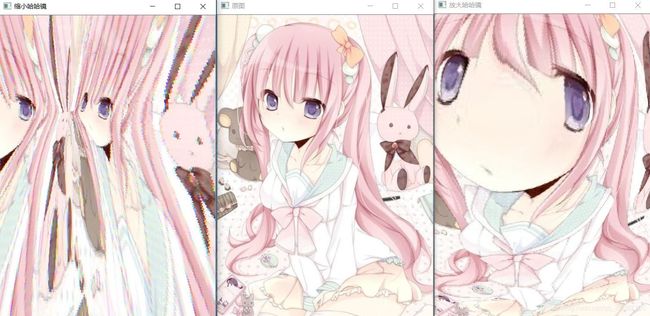opencv实现哈哈镜变换
我绝对是无聊爆炸了,所以我又丧心病狂处理二次元图片了。
今天基于像素变换来实现图像的哈哈镜变换,效果就是下面这样了:
哈哈镜分两种,一种是挤压,一种是放大。分别对应凹函数和凸函数。
输入一副图像,首先设置缩放中心center,我们取原图鼻子处为中心。
设置图像上任意一点到中心点的相对坐标tx= x-cx,ty=y-cy。
左边为挤压哈哈镜,对应像素映射函数:
//变换后新的坐标
x = cos(atan2(ty , tx))* 12*(sqrt(tx*tx + ty*ty))+cx
y = sin(atan2(ty , tx))* 12*(sqrt(tx*tx + ty*ty))+cy
公式中的常数12代表强度,越大则图像越扭曲。
自定义挤压函数(Python版)(C++版可以关注公众号查看推文):
def MinFrame(frame): #定义图像缩小函数
height, width, n = frame.shape
center_X = width / 2
center_Y = height / 2
radius = 400
newX = 0
newY = 0
real_radius =int(radius / 2.0)
new_data = frame.copy()
for i in range(width):
for j in range(height):
tX = i - center_X
tY = j - center_Y
theta = math.atan2(tY, tX)
radius = math.sqrt((tX * tX) + (tY * tY)) #与上面一样,计算公式不一样
newR = math.sqrt(radius) *12
newX = int(center_X + (newR * math.cos(theta)))
newY = int(center_Y + (newR * math.sin(theta)))
if newX < 0 and newX >width:
newX = 0
if newY <0 and newY >height:
newY = 0
if newX<width and newY<height:
new_data[j, i][0] = frame[newY, newX][0]
new_data[j, i][1] = frame[newY, newX][1]
new_data[j, i][2] = frame[newY, newX][2]
else:
new_data[j, i][0] = frame[j, i][0]
new_data[j, i][1] = frame[j, i][1]
new_data[j, i][2] = frame[j, i][2]
return new_data
右边为放大哈哈镜,对应像素映射函数:
//变换后的新坐标
x = (tx/2)*(sqrt(tx*tx + ty*ty)/radius)+cx
y = (ty/2)*(sqrt(tx*tx + ty*ty)/radius)+cy
自定义放大函数(PY版):
def MaxFrame(frame): #定义图像拉伸放大函数
height, width, n = frame.shape #获取输入图像的长宽和通道
center_X = width / 2 #计算公式
center_Y = height / 2
radius = 400 #这里直接定义半径了
newX = 0 #初始变换后的坐标
newY = 0
real_radius =int(radius / 2.0) #计算公式
new_data = frame.copy() #复制一个与原图像一样的图片
for i in range(width): #建立循环移动像素遍历宽度方向的像素
for j in range(height): #遍历高度方向的像素
tX = i - center_X #计算公式
tY = j - center_Y
distance = tX * tX + tY * tY
if distance < radius * radius: #变换点的距离是否太远
newX = int(tX/ 2.0)
newY = int(tY/ 2.0)
newX = int(newX * (math.sqrt(distance) / real_radius))
newX = int(newX * (math.sqrt(distance)/ real_radius))
newX = int(newX + center_X)
newY = int(newY + center_Y)
if newX<width and newY<height: #计算出的新坐标可能超出原图层,这里用if加以判断
new_data[j, i][0] = frame[newY, newX][0] #将计算后的坐标移动到原坐标
new_data[j, i][1] = frame[newY, newX][1]
new_data[j, i][2] = frame[newY, newX][2]
else: #若变换点距离太远,图像像素不变动
new_data[j, i][0] = frame[j, i][0]
new_data[j, i][1] = frame[j, i][1]
new_data[j, i][2] = frame[j, i][2]
return new_data
至于这俩函数怎么来的,,我也说不出啥门道来,,欢迎评论告知哈。
结语
欢迎关注公众号【Opencv视觉实践】,利用有趣的实例拯救你的视觉基础~


